The
Home Page Selection
If
you require further information on any
print featured here, please contact
us.
When
a print has been sold it will be marked
as Sold.
A
growing archive of selections
from previous Home pages is featured in
the
Home
Page Selection Archive |
|
See
also :
Click
on a thumbnail (left)
to link directly with the entry for that
print, or scroll down to view all the selected
prints from the current Home
Page.
Images
are not to relative scale (see stated dimensions) and also at only modest resolution. If you wish to view extracts of an image at higher resolution, please Contact us.
|
|
|
|
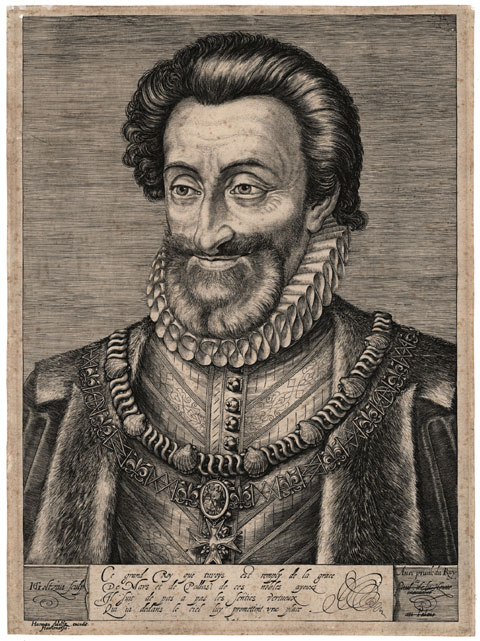
| |
HENDRIK GOLTZIUS
Mulbracht 1558 – 1616 Haarlem
Goltzius settled in Haarlem in 1576-77 as a journeyman engraver.
In 1582 he set up his own print workshop and publishing house and by the end of the decade
was the most important engraver in northern Europe.
By 1598 he decided to focus completely on painting and gave up engraving.
Among Goltzius’ last engraved portraits, Henri IV is shown wearing the French dual chivalric orders
of the Holy Spirit and St Michael, always awarded together.
As sovereign he automatically became Grand Master of the Order of the Holy Spirit.
Though he inherited the throne in 1572, the French Wars of Religion delayed Henri’s coronation until 1894.
Only after military victory and abandoning Huguenotism for Catholicism (Paris is worth a Mass)
was he accepted as king.
He tried to reconcile both religious sides in the Edict of Nantes, but was assassinated by a catholic in 1610.
Henri IV, King of France
Hollstein 193, New Hollstein 226 iv/v, Bartsch 173 ii/iii
359 x 267 mm
Original engraving, c1595-98.
With the original French address of Paul de la Houve crossed out, but not yet removed from the plate.
With the additional Haarlem address in the lower plate border of Herman Adolfz.
A 17th century impression, trimmed to the platemark top and bottom, narrow margins at the two sides.
Watermark: Strasbourg Lily.
Repaired tear into the image at top left edge. A tiny hole in the top right corner. Some foxing; time-stained in the borders.
An unidentified collector’s mark verso.
The Goltzius portrait of Henri IV is a companion to three other engravings, similar in size and format,
published by Paule de la Houve c1600, of central female figures at the French court: Henri’s sister, Catherine de Bourbon,
Duchess of Bar and Henri’s second wife, Marie de Medici (both original engravings by Johannes Wierix dated 1600)
as well as Henri’s mistress, Catherine Henriette de Balzac Dentraigues, Marquise de Verneuil, engraved by Hieronymous Wierix, 1600.
Paul de la Houve, father and son, were both publishers and printers in Flanders, before moving to Paris at the outset of the 17th century.
Herman Adolfz. was a cartographer, publisher and engraver working in Haarlem from 1607. He bought Goltzius’ plates and re-printed them.
Return to top ^ |
|
|
|
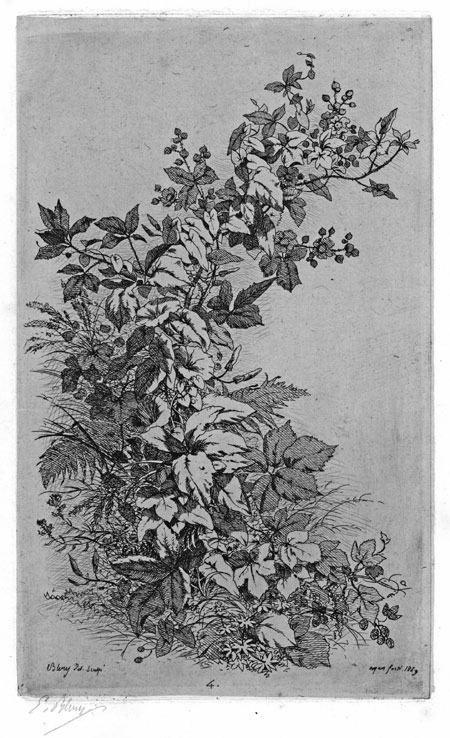 |
|
EUGENE BLERY
Fontainebleau 1805 – 1886 Paris
An amateur, Bléry was a teacher of mathematics before he decided in 1827 to become a landscape draughtsman and lithographer.
In Lyon in 1836 he encountered the etchings of De Boissieu and decided to devote himself to etching.
It was particularly the woodland landscape of his native region that supplied Bléry with his motifs.
As well as general forest studies and individual trees in the forest of Fontainebleau, Bléry etched some remarkable close-up details
of wild plants, either directly from life or from his preparatory drawings.
He exhibited at the Paris Salons, to huge success.
Ronce et Liseron Bramble and Bindweed
Bramble and Bindweed
Béraldi 189, Bléry 49
260 x 156 mm
Original etching, 1859, the plate signed and dated and numbered 4.
Plate 4 of the set of four, Les Quatre Guirlandes.
A proof signed in pencil and entitled by the artist, Branche à Ronce.
On chine appliqué on wove.
£450
Return to top ^ |
|
|
|
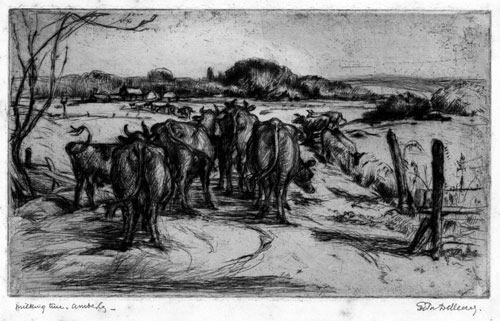 |
|
GRETA DELLEANY A.R.E.
London 1884 – 1968 Cheltenham
Beyond the work itself, not a great deal is known about Greta Delleaney.
She etched rural and architectural scenes which she exhibited at the R.A., R.S.A. and the R.E. between 1913 and 1940.
Twice she had etchings illustrated in Fine Prints of the Year, in 1923 and 1937.
She was elected an Associate of the R.E. in 1919.
After the Second World War she settled in Cheltenham, where she assisted at the Art School.
Milking Time, Amberley
113 x 189 mm
Original drypoint.
Signed in pencil and entitled.
A touched proof in a later state
“after the cows head etc”.
On cream Basingwerk parchment watermarked wove paper.
£200
Exhibited at the R.E. 1957 and the R.A. 1959
Return
to top ^ |
|
|
|
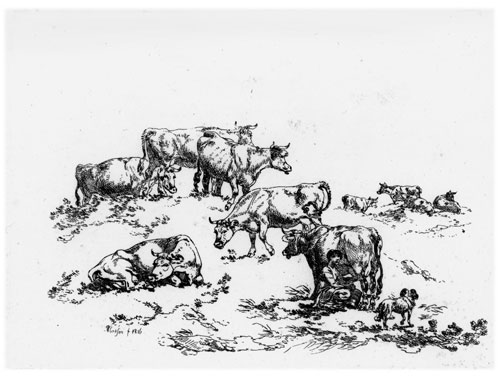 |
|
JULIUS IBBETSON
Leeds 1759 – 1817 Masham
A landscape painter, watercolourist, etcher, illustrator and poet, Julius Caesar Ibbetson settled in the Lake District 1799-1804,
before moving permanently to Masham in the North Riding of Yorkshire.
It was from Masham, in 1816, that he published by subscription, his two series of outline etchings, intended as drawing ‘books’ for amateurs.
Etchings of Cattle
230 x 302 mm (plate); 350 x 512 mm
The set of six, 1816.
Each signed and dated in the plate.
Printed on folio sheets of wove paper.
£200
Return
to top ^ |
|
|
|
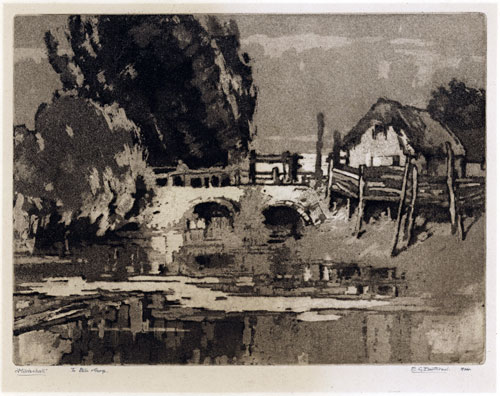 |
|
ELIAB GEORGE EARTHROWL A.R.E.
London 1878 – 1967
Sculptor, watercolour painter and etcher, Earthrowl trained at the Goldsmith’s School.
He exhibited at the R.A., the R.E., the Society of Graphic Artists and with the Printmakers’ Society of California.
Earthrowl taught at Hammersmith School of Art.
Mildenhall
247 x 335 mm
Original aquatint, 1924.
Signed in pencil, dated, entitled and dedicated “To Stella & George”.
Printed in brown ink on cream wove paper.
Sold
Exhibited at the R.E. 1924
Return
to top ^ |
|
|
|
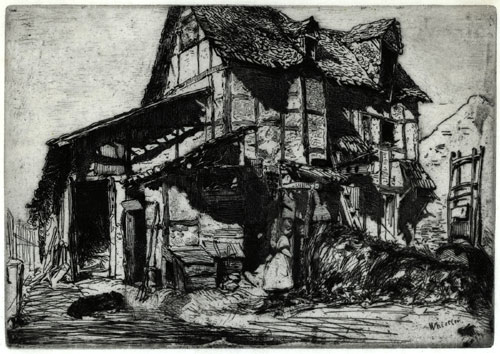 |
|
JAMES McNEILL WHISTLER
Lowell, Massachusetts 1834 – 1903 London
In the summer of 1858 Whistler, having had sales with some of his early Paris etchings,
planned a journey to Amsterdam, to look at Rembrandt, travelling there via Lorraine in north-west France and the Rhine,
with the intention of etching a group of rural subjects to complement his urban ones,
and with a view on his return to Paris of publishing a ‘set’ to establish his reputation as an etcher.
He invited the art student Ernest Delannoy to accompany him.
They were both kitted out with identical broad-brimmed hats and brown linen suits, so that Delannoy could pose
in Whistler’s place in sketches and etchings.
The Unsafe Tenement was the third plate he etched, after they had reached Alsace.
The Unsafe Tenement or The Old Farm
Kennedy 17 iv/iv; Glasgow 18 iv/iv
160 x 228 mm
Original etching 1859.
The plate signed.
Fourth, final, state, after removal of Delâtre’s name as printer.
Printed in black ink with plate tone, on thin japan.
Good condition, except for a short tear in the top right margin just extending into the image.
Sold
The Unsafe Tenement was first published, in the 2nd & 3rd states, in 1858 in Paris, as part of the Douze eaux-fortes d’après Nature (about 20 impressions), when Whistler gave its title as The Old Farm, and then in London as part of ‘The French Set’
and entitled The Unsafe Tenement (about 30 impressions). August Delâtre’s name was on the plate as printer.
After Whistler’s death the plate was probably acquired by the American dealer Frederick Keppel,
who removed Delâtre’s name before printing further impressions from it.
Return
to top ^ |
|
|
|
|
|
|
|